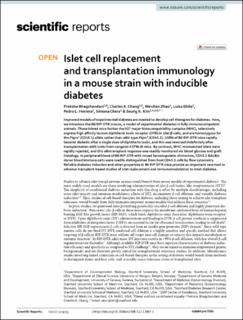| dc.contributor.author | Bhagchandani, Preksha | |
| dc.contributor.author | Chang, Charles A. | |
| dc.contributor.author | Zhao, Weichen | |
| dc.contributor.author | Ghila, Luiza Mihaela | |
| dc.contributor.author | Herrera, Pedro L. | |
| dc.contributor.author | Chera, Simona | |
| dc.contributor.author | Kim, Seung K. | |
| dc.date.accessioned | 2022-12-01T13:56:24Z | |
| dc.date.available | 2022-12-01T13:56:24Z | |
| dc.date.created | 2022-09-02T12:39:10Z | |
| dc.date.issued | 2022 | |
| dc.identifier.issn | 2045-2322 | |
| dc.identifier.uri | https://hdl.handle.net/11250/3035407 | |
| dc.description.abstract | Improved models of experimental diabetes are needed to develop cell therapies for diabetes. Here, we introduce the B6 RIP-DTR mouse, a model of experimental diabetes in fully immunocompetent animals. These inbred mice harbor the H2b major histocompatibility complex (MHC), selectively express high affinity human diphtheria toxin receptor (DTR) in islet β-cells, and are homozygous for the Ptprca (CD45.1) allele rather than wild-type Ptprcb (CD45.2). 100% of B6 RIP-DTR mice rapidly became diabetic after a single dose of diphtheria toxin, and this was reversed indefinitely after transplantation with islets from congenic C57BL/6 mice. By contrast, MHC-mismatched islets were rapidly rejected, and this allotransplant response was readily monitored via blood glucose and graft histology. In peripheral blood of B6 RIP-DTR with mixed hematopoietic chimerism, CD45.2 BALB/c donor blood immune cells were readily distinguished from host CD45.1 cells by flow cytometry. Reliable diabetes induction and other properties in B6 RIP-DTR mice provide an important new tool to advance transplant-based studies of islet replacement and immunomodulation to treat diabetes. | en_US |
| dc.language.iso | eng | en_US |
| dc.publisher | Springer Nature | en_US |
| dc.rights | Navngivelse 4.0 Internasjonal | * |
| dc.rights.uri | http://creativecommons.org/licenses/by/4.0/deed.no | * |
| dc.title | Islet cell replacement and transplantation immunology in a mouse strain with inducible diabetes | en_US |
| dc.type | Journal article | en_US |
| dc.type | Peer reviewed | en_US |
| dc.description.version | publishedVersion | en_US |
| dc.rights.holder | Copyright 2022 the authors | en_US |
| dc.source.articlenumber | 9033 | en_US |
| cristin.ispublished | true | |
| cristin.fulltext | original | |
| cristin.qualitycode | 1 | |
| dc.identifier.doi | 10.1038/s41598-022-13087-3 | |
| dc.identifier.cristin | 2048266 | |
| dc.source.journal | Scientific Reports | en_US |
| dc.identifier.citation | Scientific Reports. 2022, 12, 9033. | en_US |
| dc.source.volume | 12 | en_US |

